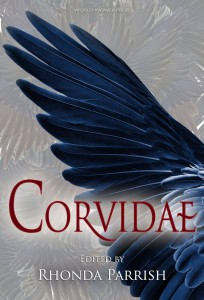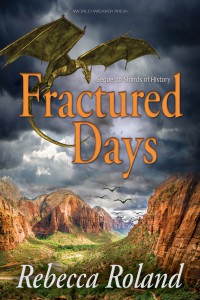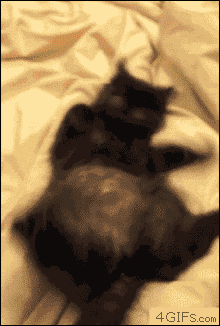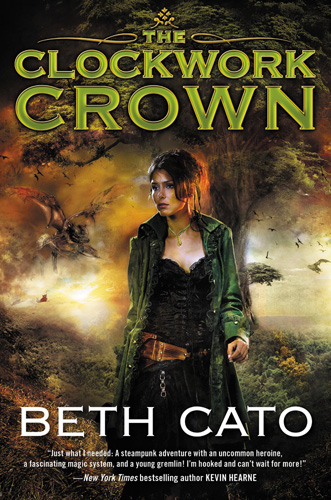VNSA 2016
If you’re in the Phoenix, Arizona, area, make note that this weekend is the fantastic, glorious, squee-inducing VNSA Book Sale! This is one of the biggest used book sales in the whole country and it takes up an entire exhibition hall of the State Fairgrounds. See this pic I took last year?
That picture was taken on Sunday, which is the LEAST CROWDED of the two days. Saturday is crazy because people line up hours before it opens, the fire marshal regulates how many people can enter the building, and it is really an overwhelming number of books and people. I like Sunday because it’s easier to browse AND all of the normal books are 50% off. This year Sunday happens to be Valentine’s Day. I told my husband that the VNSA sale is what I want. That’s how I roll.
If you go, be sure to take a rolling cart, tote bag, or some way to carry books. Don’t trust your arms alone to safely your treasures.
Read MoreRevising with Timelines with guest Laura Bickle
Today I welcome fellow Harper Voyager Impulse author Laura Bickle. Her latest book, Mercury Retrograde, is out today! The first book in the series is Dark Alchemy. Both sell for just $2.99.
Laura’s going to provide some great advice for writers on how to manage time… not time to write, but the timeline of events within your story.
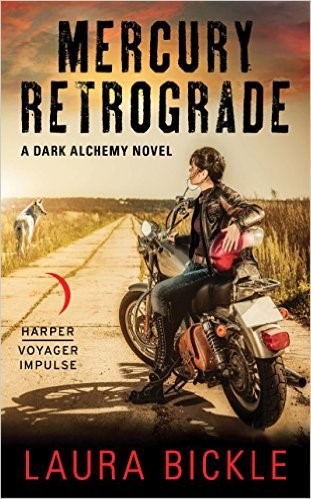 Writers tend to get into a lot of trouble with time. There’s making time to write, managing deadlines, and the vagaries of market timing.
Writers tend to get into a lot of trouble with time. There’s making time to write, managing deadlines, and the vagaries of market timing.
One issue with time, however, is entirely within the author’s control. And that’s the timeline of the story.
I never paid a whole lot of critical attention to time when I read. Sure, I was conscious that some passages in stories could be languid and slow-moving like a drippy faucet. Others were exhaustingly rushed. I never was quite able to put my finger on why.
And then, when my first book was accepted for publication, I discovered the answer: books can grow timeline issues. They’re very subtle, but can really cause problems with the reader’s perception of a work.
A timeline problem occurs when characters have too many events crammed into a period of time – or not enough. A succession of tasks emerges that would require the bending of the rules of the space-time continuum or superhuman abilities to accomplish. It occurs when your main character hasn’t slept for days. It happens when she travels an impossible distance in an hour. It can take place when your main character hasn’t worked regular hours at her day job without explanation. This goes for crazy amounts of overtime, or not working at all. It happens when your character is doing “cop stuff” for seven days in a row without a day off or at least a pro forma request for overtime. It’s easy for an author to lose track of what day it is, and a character can get trapped in a month-long weekend or a year of Wednesdays.
Mundane concerns? Maybe. But they catch an editor’s eye and seep into the subconscious of the reader. And sometimes, we’ve gotta pay attention to the rules of the real world – like time – in order to allow the reader to suspend disbelief for the really magical things we want to do with the story.
My first editor asked me to turn a timeline in with my book. Something simple, listing the day, night, and all the scenes that happened in each. By reviewing my manuscript in this way, I could see where I crammed too many activities into the heroine’s day – or (eep!) not enough. When I finish a draft, I read through it and start constructing my timeline.
I also create a second list that’s not strictly a timeline. It’s one that notes where chapters begin and end, how many scenes are included in the chapter, and how many pages each chapter is. Sticking a ten-page chapter next to a twenty-five page chapter creates unevenness, and keeping a note helps me be more aware of it. It also shows me where I have a bunch of stubby two-page scenes strung together. This causes me to question whether I’m head-hopping or whether I really need to find a way to collapse those scenes into less choppy ones. It helps me analyze flow. It also shows me whether I’m doing a good job of ending chapters in the middle of the action, causing the reader to want to turn the page to the next.
By doing this kind of post-hoc analysis, and correcting the results, I found that pacing issues automatically ironed themselves out.
I’ve turned a timeline in for every book since, whether or not I was asked. And it’s really reduced the amount of time I spend fixing structural issues in revisions. Now, I tend to work with that timeline in my head, and it keeps me honest. It keeps my very human characters from turning into Wonder Women and Supermen.
Not only do I have to manage time, but my characters do, too. Maintaining a timeline is a front-line editing fix I suggest that every writer keep in the toolbox.
Laura Bickle grew up in rural Ohio, reading entirely too many comic books out loud to her favorite Wonder Woman doll. Her most recent novel is MERCURY RETROGRADE (Harper Voyager Impulse). The latest updates on Laura’s work can be found at www.laurabickle.com.
Read MoreSomething venomous has come to Temperance …
It’s been two months since Petra Dee and her coyote sidekick Sig faced off against Temperance’s resident alchemist, but things are far from quiet. When an Internet video of a massive snake in the backcountry of Yellowstone goes viral, a chase for the mythical basilisk is on. Monster hunters swarm into the area, and never one to pass up the promise of discovery, Petra joins in the search.
Among the newcomers is a snake cult on wheels―the biker gang Sisters of Serpens. Unlike some, the Sisters don’t want to kill the basilisk―they want to worship it. But things get complicated when the basilisk develops a taste for human flesh that rivals the Sisters’ own murderous skills.Meanwhile, the alchemical tree of life is dying, and the undead Hanged Men of Temperance who depend on it know the basilisk may be their last chance for survival.
With time running out for everyone around her, Petra will be forced to decide who survives and who she must leave behind in this action-packed sequel to Dark Alchemy.“This wonderfully unusual Weird West novel combines the best of contemporary fantasy with metaphysical magic and mayhem, and even a bit of romance.” – Publishers Weekly Starred Review
CORVIDAE is out!
My friend and editor Rhonda Parrish has a new book out this week called Corvidae. I don’t have a story in this anthology (though I do have one in her previous Magical Menagerie book, FAE), which meant I had the opportunity to read the book early for the purposes of providing a blurb. I was very happy to do so!
“Corvidae evokes the majesty and mischief of corvid mythologies worldwide–and beyond our world–in a collection that is fresh and thoroughly enjoyable.”
– Beth Cato, author of The Clockwork Dagger
Here’s more about the book:
Associated with life and death, disease and luck, corvids have long captured mankind’s attention, showing up in mythology as the companions or manifestations of deities, and starring in stories from Aesop to Poe and beyond.
In Corvidae birds are born of blood and pain, trickster ravens live up to their names, magpies take human form, blue jays battle evil forces, and choughs become prisoners of war. These stories will take you to the Great War, research facilities, frozen mountaintops, steam-powered worlds, remote forest homes, and deep into fairy tales. One thing is for certain, after reading this anthology, you’ll never look the same way at the corvid outside your window.
Edited by Rhonda Parrish
“Introduction” by Rhonda Parrish
“A Murder of Crows” by Jane Yolen
“Whistles and Trills” by Kat Otis
“The Valravn” by Megan Fennell
“A Mischief of Seven” by Leslie Van Zwol
“Visiting Hours” by Michael S. Pack
“The Rookery of Sainte-Mère-Église” by Tim Deal
“The Cruelest Team Will Win” by Mike Allen
“What Is Owed” by C.S.E. Cooney
“Raven No More” by Adria Laycraft
“The Tell-Tale Heart of Existence” by Michael M. Rader
“Sanctuary” by Laura VanArendonk Baugh
“Knife Collection, Blood Museum, Birds (Scarecrow Remix)” by Sara Puls
“Flying the Coop” by M.L.D. Curelas
“Postcards from the Abyss” by Jane Yolen
“Bazyli Conjures a Blackbird” by Mark Rapacz
“Seven for a Secret” by Megan Engelhardt
“Flight” by Angela Slatter
Available on Amazon, Barnes & Noble, and directly from World Weaver Press (with links to more vendors, too).
Read MoreA.F.E. Smith’s DARKHAVEN Blog Tour: Excerpt plus Giveaway!
I’m happy to welcome fellow Harper Voyager author A.F.E. Smith to my blog today! Her fantasy novel Darkhaven came out yesterday in ebook and will be in paperback on January 14th 2016. Isn’t her cover awesome? Here’s a lot more info about the book… as well as a Rafflecopter giveaway and scavenger hunt clue!
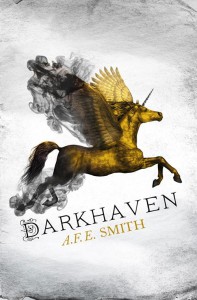 Ayla Nightshade never wanted to rule Darkhaven. But her half-brother Myrren – true heir to the throne – hasn’t inherited their family gift, forcing her to take his place.
Ayla Nightshade never wanted to rule Darkhaven. But her half-brother Myrren – true heir to the throne – hasn’t inherited their family gift, forcing her to take his place.
When this gift leads to Ayla being accused of killing her father, Myrren is the only one to believe her innocent. Does something more sinister than the power to shapeshift lie at the heart of the Nightshade family line?
Now on the run, Ayla must fight to clear her name if she is ever to wear the crown she never wanted and be allowed to return to the home she has always loved.
HarperCollins
Amazon (global link)
Barnes & Noble
Google Play
iBooks
Kobo
Excerpt
Ayla descended a short flight of steps cut into a sheer rock face, and found herself on a ledge overlooking the lower rings of the city. Tiered roofs stretched down and out, red tiles and golden wood and grey-blue slate. She identified the dark smoke rising from the factories, as well as several lighter puffs of steam – travelling fast – which must be the trams that partly circled the lower rings. Even from here, with four rings behind her and only two ahead, the city merged into the horizon. She couldn’t make out where Arkannen ended and the rest of Mirrorvale began.
Of course, she had seen the city many times from the air, at night, but the sheer scale of it had never impressed itself upon her as it did now. From above, Arkannen was orderly and structured, seven neat rings descending in sequence. She hadn’t realised how much bigger and more complicated it would appear when she was actually in it. It was daunting, but it was also encouraging. As long as she was careful and didn’t draw attention to herself, she didn’t see how anyone would ever find her.
Dragging herself away from the view, she plunged into the darkness of the narrow passage that cut into the rock behind her. She emerged into a spacious, paved square with various streets and staircases joining it on three sides. On the fourth side stood a high-arched gateway, the sole route into the second ring: the Gate of Wind. Although each of the gates Ayla had passed through so far had been impressive, she thought this one might be the most spectacular of all. The arch was carved from pale, translucent marble, a series of abstract curved shapes swirling around each other like the patterns of the breeze; in every gap hung delicate crystals that tinkled with the slightest movement of the air, so that the gate was never silent. In the centre of the square, a three-bladed sail on a long pole turned with the currents, marking wind speed and direction for the captains of the airships.
None of the other gates had posed a problem, but even so, Ayla pulled her hood forward to hide her face before she joined the workers who were converging on the gate from all directions. It was even busier down here than it had been in the higher rings. An elbow caught her in the ribs; she stumbled, and someone trod on her foot. Then, as she passed under the archway itself in a squeeze of tight-knit crowd, she overheard a snippet of conversation.
‘Murdered in his bed … the old Changer …’
In an instant, the press of people around her – their heat and smell – became unbearable. She tried to keep up with the two men who were talking, but they were borne away from her like twigs in the relentless current. The many voices of the crowd became a tumult, a hundred different words competing for attention. Ayla snatched at one sentence, then another, letting each one slip away as she became aware of the next. But she heard nothing more about her father. Perhaps her overwhelmed brain had conjured up a phantom.
A.F.E. Smith is an editor of academic texts by day and a fantasy writer by night. So far, she hasn’t mixed up the two. She lives with her husband and their two young children in a house that someone built to be as creaky as possible – getting to bed without waking the baby is like crossing a nightingale floor. Though she doesn’t have much spare time, she makes space for reading, mainly by not getting enough sleep (she’s powered by chocolate). Her physical bookshelves were stacked two deep long ago, so now she’s busy filling up her e-reader.
What A.F.E. stands for is a closely guarded secret, but you might get it out of her if you offer her enough snacks.
Website
Facebook
Twitter
DARKHAVEN on Goodreads
Read More
Author Rebecca Roland: The Majesty of Dragons
Today I welcome author Rebecca Roland, author of the just-released Fractured Days, the second book in her Shards of History series from World Weaver Press. She’s here today to talk about her love of dragons.
I am one of those fantasy readers who loves dragons. I love Anne McCaffrey’s Dragonriders of Pern, I love Temeraire in Naomi Novik’s alternate history series of the same name, and you’d better believe I seriously considered dressing as Daenerys Targaryen for Halloween last year. Dragons are truly awesome. They’re huge, they’re powerful; they breathe fire for crying out loud!
My first encounter with a dragon as a kid was Puff the Magic Dragon. I watched the cartoon endlessly. I knew all the lyrics to the song at one point (I tried singing it right now and after a couple of lines started humming). Puff is one of those stories about growing up and losing the magic of childhood. As a kid, those types of stories always made me sad (and they still do). It’s like losing the part of yourself that thinks of all the possibilities. Part of me saw Puff as a warning against growing up too much, if that makes any sense. I definitely believe in keeping in touch with one’s inner child. Otherwise (and pardon me for sounding a little new agey), you might lose touch of where to find the deepest joy within yourself.
But I think I really fell in love with dragons when I watched The Neverending Story. Falcor was a gentle dragon, and he was furry and cuddly and enjoyed scratches behind his ears like a great big sweet dog. And when Bastian or Atreyu rode on Falcor, I felt like I was flying along with them. That has got to be one of the best advantages of having a large dragon. If you can’t smite your enemies from the air, you can fly away from them quickly.
Since I love dragons so much, I had to include them in my Shards of History series. I didn’t want them to overpower the plot too much, though. As cool as dragons are, I didn’t mean for them to be the focus of the series. They are more like horses in the books. They’re mounts for the Maddion, who use the fire-breathing dragons to their full advantage, striking quickly from the air and inspiring terror in whoever they attack. The dragons can’t communicate like Temeraire, nor are they intelligent like him. If they were, the Maddions’ power would far outweigh that of my antagonists.
Dragons can be beastly, beautiful, enormous, or tiny enough to ride on one’s shoulder. They can be clever or not. Perhaps they breathe fire, or maybe they spit acid instead. They might allow you to ride on their backs, or they might turn you into barbeque and then pick their teeth with your femur. Dragons demand respect and wonder. I always dreamed of having a dragon on the cover of one of my books, and that dream has, at last, come true.
BIO:
Rebecca is the author of the Shards of History series, The Necromancer’s Inheritance series, and The King of Ash and Bones, and Other Stories. Her short fiction has appeared in publications such as Nature, Fantastic Stories of the Imagination, Stupefying Stories, Plasma Frequency, and Every Day Fiction, and she is a graduate of the Odyssey Writing Workshop. You can find out more about her and her work at rebeccaroland.net or follow her on Twitter at @rebecca_roland.
Fractured Days at World Weaver Press
Read MoreGoing Big Time
I had a big ol’ pile of links the other day and today I return with even more. I mean, whoa. The attention this week. My mind is all…
Review of Clockwork Crown at NPR.org. …”Although Crown operates on a sprawling scale, it’s impeccably paced and compact, making for a potent conclusion to Cato’s rousing steampunk tale as well as a study in how less can be so much more.”
My post at John Scalzi’s Big Idea: Healers are heroes too, darnit.
Over at Bookish I have a list of five diverse steampunk books.
The Hook: The Clockwork Crown at Alex Shvartsman’s blog.
Wednesday morning I was interviewed by Professor Terry Lovell at KYCA out of Prescott. For a limited time, you can listen to that here. [Note: I was SO NERVOUS doing the interview but I made it through! I think I earned a piece of the Triforce for that.]
The wonderful David Nilsen at the Greenville, Ohio, Public Library invited me back to the Fourth & Sycamore blog with an interview and excerpt.
Wag the Fox interviewed me at Heavy Is the Steampunk That Wears the Crown: an interview with Beth Cato, author of “The Clockwork Crown.”
Romantic Tension in The Clockwork Crown at Coffee Time Romance.
Read More




